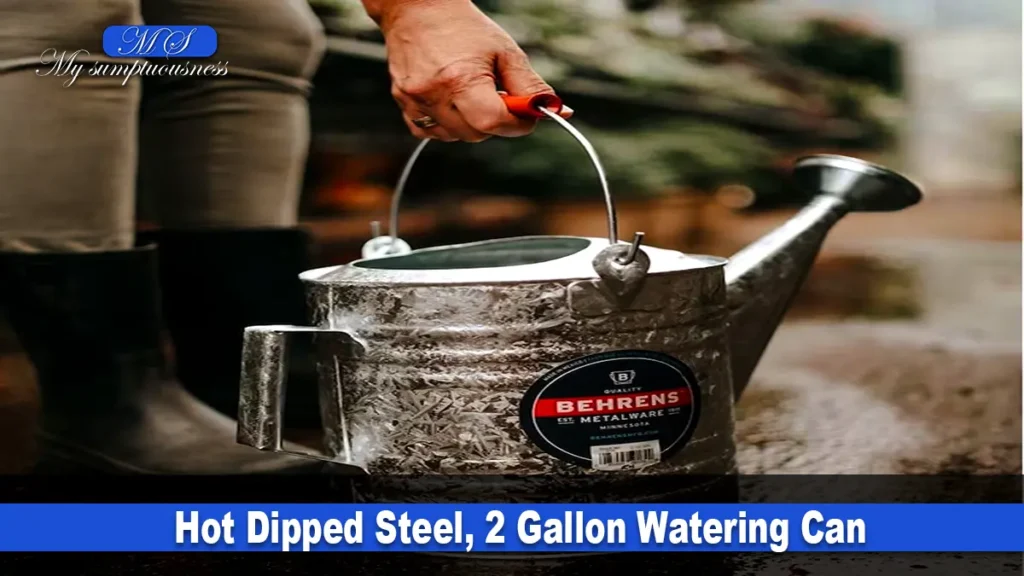Last Updated on 24 September 2023 by mysumptuousness.com
Timeless, useful, and even decorative, a watering pot is the essential tool of the real anthophillic gardener. The history of the watering pot is very fascinating, and it would take hours and hours to tell you about it. But can you even imagine what the first can be like?
Introduction
Initially, the watering pot was just a pouch of goatskin that was used to transport water from place to place, just like a present-day bottle. Then, as the years passed, the can have evolved its shape. At first, the watering pot saw its shape grow into chantepleure, and then it took the form of a funnel. It had no spout tube or a handle and closely resembled the coloquinte fruit. Then, as the years passed, the can became of the shape as we see it now.
Plastic, Copper, or Zinc Watering Can

Whether your can is a metal or a plastic can, it’s only a question of taste and style but also of strength, weight, and ease. Plastic can is basically a much cheaper can, with higher flexibility and lighter weight. It allows this plastic can to better withstand the shocks without destroying itself. But it is damn clear that it becomes less solid and less pretty over time.
So, should we choose a metal watering can?
There is, of course, a vibe in a metal can, and it is even decorative. The charm of a zinc watering can is unique. Since these cans are also very strong, they last longer and do not even rust. Whether they are zinc, copper, or galvanized watering cans, they all contain traces of the elements essential to man. They also possess a sanitizing effect on the water. Zinc oxide provides fungicidal and antiseptic properties.
Storing and Maintaining your watering pot

Proper care and maintenance of the can prolong its lifetime. After the use, empty the remaining water and clean the can to stop the growth of algae or mineral deposits.
Shopping for Plant Watering Cans
The best plant watering pots are not only functional but also nice looking. The real challenge may be one from amongst them.
You don’t especially require an ergonomic, beautiful indoor watering can to keep your plants alive. All you need to care about is that it doesn’t hurt after having one.
For small indoor pots, an indoor can with a narrow spout tube provides the best accuracy. For larger pots, one having a rain shower rose can provide a gentle spray. A can with a removable rose can do the best. Another benefit of having a proper Home Depot watering can is that many of them are appealing even when they’re for show.
Some types of Home Depot Watering Can;
Plastic Watering Can

Plastic can have a two-liter capacity.

Watering pots may be in silver, gold, or black finish.
Black Matte Round Metal Can
This zinc or copper watering can have a two-quart capacity.
Haws Watering Can

Powder-coated Haws can come with a removable brass rose and mister.
Hot Dipped Steel, 2 Gallon Watering Can

This Galvanized watering can comes with a red wooden handle.
Why Are Gardeners So Crazy About the Haws Watering Pot?
A haws watering pot is totally lenient. I get it. But the copper Haws can not be your average watering pot. A few years ago, the watering pot was decidedly out of budget. One quickly becomes obsessed. I searched through YouTube videos of the watering plant (basically Haws watering pot). I admired the glossy old cans while scrolling through the videos.
History
A watering pot is a portable container with a funnel and a handle. It is used to water plants. It has been in use for the last 2000 years and has since gone through many improvements in design. Apart from watering plants, it has various benefits, as it is quite a fair and versatile tool.
Capacity
The capacity of the container starts from 0.5 liters (as indoor watering cans) to 10 liters (2 gallon watering cans). It is usually made of plastic, metal, or ceramic. At the end of the spout tube, a “rose” (a design like a cap, with small holes) is present to break the stream of water into many droplets to avoid more water use on the soil or on other delicate plants.
Etymology
The term “watering can” was first used in 1692 in the diary of an anthophillic cottage gardener, Lord Timothy George of Cornwall. Before that, it was popular as a “watering pot.” In 1886, the Haws watering can was created by John Haws. Mr. Haws said, “My this latest invention changes a watering pot into a kind that is much more easier to carry and pick.”
FAQS
Using a watering pot to water plants saves us from having so many and multiple trips again and again to sink. The best watering cans are created out of the best materials and are comfortable to hold (even when it is complete).
While a watering pot may be much for watering a plant or some more, using it may be a chore. Instead, you can find it much simpler to use as a sprinkler or irrigation hose than all of those so many trips to the faucet to refill the watering pot.
Proper care and maintenance of the can prolong its lifetime. After the use, empty the remaining water and clean the can to stop the growth of algae or mineral deposits.
Both metal and plastic watering cans are equally useful and good, but they have some slight differences. Plastic cans are of lightweight and just last for some decades, especially if they’re of high quality plastic.
Copper or zinc cans can likely last longer than brass, galvanized steel, or plastic cans. We can easily see decades-old Haws cans on eBay.